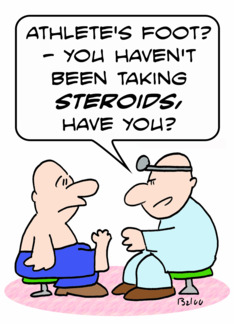
With the Super Bowl on the horizon, let’s talk about a foot condition that plagues many athletes. In fact, it is so popular in the locker rooms that it has earned its own sports name. That infamous bug is referred to as none other than Athlete’s Foot.
Athlete’s foot is a fungus that can be transferred from person to person. It thrives in dark, wet, secluded locations such as locker room floors, showers and in between your toes. So, we’ve all heard the drill, we are supposed to wear shower shoes when we are showering in a public restroom. This is because in theory, we are preventing our feet from directly touching the same wet floor that everyone else has had their food on. Unfortunately, that is just not enough. More importantly, you need to very thoroughly dry the spaces between your toes. This is where the fungus takes off typically, because of that perfect environment described above. For some of us though, the pores of our feet secrete a greater amount of sweat than the average person. For these people, it is especially important to be changing your socks a couple of times a day and drying off your feet to try and reduce the moisture on your feet.
Athlete’s foot can be difficult because it has many different patterns of presentation. There is a commercial out right now that says most athlete’s foot starts between your 3rd and 4th toe. Now, although this is true, most people don’t notice it until it has progressed to several of their toes or even a good portion of their foot. Athlete’s foot can range from dry skin to cracked, itchy, burning or even blisters. Due to its wide range of appearances, it can be difficult to diagnose right away. Often times, your physician will start you on some over the counter treatments that will hopefully stop the fungus and kill it off. If this does not work, there are some prescriptions that are more potent and will stop the infection. If none of this works though, your physician may want to do a biopsy of the area to determine what exactly is causing your problem. There are several other dermatological conditions that look very similar to Athlete’s foot. If you are in the Newburyport, Chelmsford, Lowell or North Andover, Massachusetts area and you are experiencing any of these symptoms, please feel free to contact us and our office staff would be more than happy to help you start a treatment plan and get back up on your feet.
With all of this said, the most important key to Athlete’s foot is prevention. So, make sure you are keeping those toes nice and dry. This will help keep the fungus away and keep you in the game.



